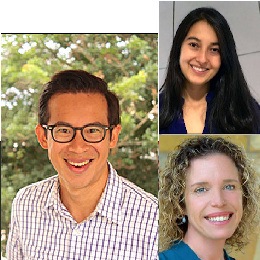Event Date:
Event Date Details:
A webinar using Zoom software (meeting ID 644-027-449) https://ucsb.zoom.us/j/644027449
Related Link:
Presentation 1: Ultraviolet radiation decreases COVID-19 growth rates: Global causal estimates and seasonal implications
Kyle Meng, PhD
Professor of Economics and Environmental Science and Management, UCSB
Abstract: Nearly every country is now combating the 2019 novel coronavirus (COVID-19). A central concern is whether COVID-19 transmission exhibits seasonality. If so, changing environmental conditions in coming months may shift COVID-19 infection patterns and policy responses around the world. We estimate a relationship between growth of confirmed cases of COVID-19 and local environmental conditions by combining the most spatially-disaggregated global dataset of daily cases assembled to date, consisting of 3,235 administrative units across 173 countries, with a statistical model isolating random variation in daily weather conditions. Our analysis indicates a strong effect of ultraviolet radiation (UV) on daily COVID-19 growth rates: a 1 kJ m−2 increase in hourly UV decreases the growth rate of confirmed COVID-19 cases by .09 percentage points (±.04, p =.01), with a delayed effect that manifests over two weeks. We find weak or inconsistent lagged effects of local temperature, specific humidity, and precipitation. To illustrate the seasonal implications of our findings with respect to UV, we show that estimated UV effects imply decreases in COVID-19 growth rates of 1.18 percentage points (±0.47) in the extra-tropical Northern Hemisphere and increases of 2.1 percentage points (±0.83) in the extra-tropical Southern Hemisphere between April and July 2020. Seasonality in UV dictates the inverse pattern for January 2021, with COVID-19 growth rates rising by 5.5 percentage points (±2.18) in the extra- tropical Northern Hemisphere and falling by 4.82 percentage points (±1.91) in the extra-tropical Southern Hemisphere, relative to April 2020. These effects are substantial when compared to the average in-sample COVID-19 growth rate of 13.21 percent. The total seasonal effect of all climate variables investigated is indeterminate in sign due to uncertainty in the effects of temperature and specific humidity. Although many factors will influence future COVID transmission, our findings suggest a need for adjustment of COVID-19 containment policies for the seasonality of UV.
Kyle Meng is an Assistant Professor at the Bren School and the Department of Economics at the University of California, Santa Barbara. He is also a Faculty Research Fellow at the National Bureau of Economic Research (NBER). His research is primarily in environmental, energy, and resource economics with a focus on advancing the empirics of climate change economics.
Presentation 2: COVID-19 Testing Strategies and Capacity: Where are we and where do we need to be?
Carolina Arias Gonzalez, PhD
Assistant Professor in Molecular, Cellular, and Development Biology, UCSB
Lynn N. Fitzgibbons, MD
Infectious Disease Specialist, Cottage Health, Santa Barbara
Abstract: The phasing out of COVID-19 shelter-in-place measures and the safe re-opening of communities and economies around the world rely on widespread testing and expansive contact tracing capabilities. The wide use of these tools is imperative to understand the dynamics of viral transmission in our communities, and for the early detection and control of potential outbreaks. To date, the US has conducted close to 10 million tests (3% of the population), and the daily capacity is about 400,000 tests. Recent efforts focus on the development of efficient, sensitive, and scalable methods for testing. At UCSB, we have developed a CRISPR-based, low-cost, and field-deployable method to test for the presence of SARS-CoV-2 in samples. Our assay, known as CREST (Cas13-based, rugged, equitable scalable testing), performs equally well to the commonly used RT-qPCR assays allowing us to detect viral sequences in samples. We will use CREST and RT-PCR to evaluate the prevalence of SARS-CoV-2 in our population. For this effort, we have partnered up with the UCSB student health office and our colleagues at the Santa Barbara Cottage hospital to deploy a surveillance study in 1500 healthy, asymptomatic individuals in our community. Recent evidence indicates that pre-symptomatic and asymptomatic individuals carry and shed the virus, increasing the potential of covert virus transmission. Monitoring the presence of the SARS-CoV-2 in our population will allow us to rapidly identify transmission events, and control potential outbreaks with the ultimate goal of protecting our community.
Dr. Arias (Ph.D. Microbiology, New York University Sackler Institute for Graduate Biomedical Sciences) has extensively studied virus-host interactions, as well as drug screens to identify FDA-approved compounds that could be used to curtail Zika virus infection. Dr. Arias joined the UCSB faculty late in 2016.
Dr. Fitzgibbons is board certified in Infectious Diseases and Internal Medicine, and is chair of the Division of Infectious Desease at Cottage Health. She is the Medical Education Director of Resarch and Quality, and is a Clinical Associate Professor Medicine at USC, as well as Adjunct Assistant Professor at UCSB in the Geography Department. She oversees the HIV and Infectious Disease clinic at the Santa Barbara County Public Health Department.
Please join us for this exciting seminar series. Sign up here to receive updates by email about this series.
Sponsored by UCSB's Interdisciplinary Research Centers, NOVIM, and Cottage Health.



